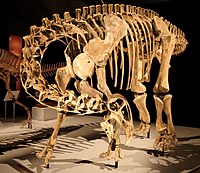
Photo from wikipedia
Postcranial skeletal pneumaticity, air‐filled bones of the trunk and limbs, is exclusive to birds among extant tetrapods and exhibits significant variation in its expression among different species. Such variation is… Click to show full abstract
Postcranial skeletal pneumaticity, air‐filled bones of the trunk and limbs, is exclusive to birds among extant tetrapods and exhibits significant variation in its expression among different species. Such variation is not random but exhibits relationships with both body mass and locomotor specializations. Most species‐level comparative research to date has focused on aquatic‐oriented taxa (e.g., Anseriformes). The lack of data from non‐aquatic birds constrains our ability to characterize global (i.e., avian‐wide) patterns of this trait complex. To address this gap, the study conducted herein quantified postcranial pneumaticity in Accipitrimorphae, a mostly terrestrial clade composed of species that span a range of body sizes and exhibit diverse flight/foraging behaviors. All examined species (n = 88) invariably pneumatized the postaxial through pre‐caudal vertebrae, sternum, coracoid, humerus, vertebral and sternal ribs, and pelvic girdle, a pattern herein referred to as the accipitrimorph baseline. Of the 88 sampled species, 41 expanded upon this pattern, whereas 10 species exhibited a reduction. No species deviated from the accipitrimorph baseline by more than two anatomical regions. A phylogenetically‐informed regression analysis failed to identify a significant relationship between body mass and pneumaticity. However, specific pneumaticity phenotypes deviating from the baseline were correlated with aspects of wing morphology, tail length, and home range size. Results from this and previous studies provide clarity on two hypotheses: (1) aquatic taxa display distinct pneumaticity expression patterns relative to non‐aquatic birds, notably with reductions in the proportion of the skeleton filled with air in diving specialists and (2) contemporary comparative studies, including the one herein, that explicitly account for phylogenetic relationships consistently fail to support the oft‐cited positive relationship between pneumaticity and body mass. Instead, historical relationships and functional/ecological attributes (e.g., diving, specialized flight behaviors) appear to be the primary drivers underlying patterns of variation in this trait complex.
Journal Title: Journal of Anatomy
Year Published: 2022
Link to full text (if available)
Share on Social Media: Sign Up to like & get
recommendations!